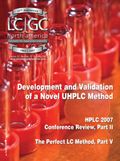Gas Chromatography–Mass Spectroscopy
Gas chromatography–mass spectrometry (GC–MS) is the most widespread tandem technique in the analytical instrumentation industry. In fact, these systems account for the largest installed base of mass spectrometry instruments.
Gas Chromatography–Mass Spectroscopy
Gas chromatography–mass spectrometry (GC–MS) is the most widespread tandem technique in the analytical instrumentation industry. In fact, these systems account for the largest installed base of mass spectrometry instruments. GC–MS systems are extremely versatile and are employed across many different industries, particularly for environmental, chemical, and toxicological applications. But it is also a mature market, based predominantly upon replacement system sales and aftermarket revenue. In addition, growth of GC–MS systems comes in part at the expense of GC as many labs replace their GCs with GC–MS systems.

GCâMS demand by region.
There are several types of mass analyzers used in GC–MS, which include quadrupole, ion trap, magnetic sector, and time-of-flight. Quadrupole analyzers are by far the most popular variety of mass analyzers because they provide a reliable, cost-effective, and robust solution to most applications. However, the demand for other classes of mass analyzers is fueling growth in the GC–MS market as a result of a growing trend of applications requiring lower detection limits and better resolution.
Magnetic sector mass spectrometers are the oldest mass spectrometry technology and provide highly reproducible results combined with high resolution and sensitivity. Ion trap systems are gaining wider acceptance in the marketplace as they offer high sensitivity and simple maintenance. Ion Trap GC–MS offers tandem MS, which improves selectivity in the analysis of mixtures, lowers detection limits, and provides structural information, which is applicable to forensic and life science applications, particularly drug discovery, synthesis, and metabolism.
Time-of-flight analyzers are the youngest of GC–MS technologies. They provide the quickest analysis and have the highest practical mass range of all analyzers. GC-TOF systems are relatively expensive, costing upwards of $150,000. However, most advocates of the technology agree that the systems are worth the investment.
North America and Europe account for nearly three-quarters of the worldwide GC–MS demand. However, Japan and ROW, particularly China, are among the fastest growing regions due to a variety of environmental concerns and its rapidly evolving petroleum refining industry.
The foregoing data was extracted and adapted from SDi's Global Assessment Report, 9th Edition. For more information, contact Glenn Cudiamat, VP of Research Services, Strategic Directions International, Inc., 6242 Westchester Parkway, Suite 100, Los Angeles, CA 90045, (310) 641-4982, fax: (310) 641-8851, e-mail: cudiamat@strategic-directions.com

New Study Reviews Chromatography Methods for Flavonoid Analysis
April 21st 2025Flavonoids are widely used metabolites that carry out various functions in different industries, such as food and cosmetics. Detecting, separating, and quantifying them in fruit species can be a complicated process.
University of Rouen-Normandy Scientists Explore Eco-Friendly Sampling Approach for GC-HRMS
April 17th 2025Root exudates—substances secreted by living plant roots—are challenging to sample, as they are typically extracted using artificial devices and can vary widely in both quantity and composition across plant species.
Sorbonne Researchers Develop Miniaturized GC Detector for VOC Analysis
April 16th 2025A team of scientists from the Paris university developed and optimized MAVERIC, a miniaturized and autonomous gas chromatography (GC) system coupled to a nano-gravimetric detector (NGD) based on a NEMS (nano-electromechanical-system) resonator.

.png&w=3840&q=75)

.png&w=3840&q=75)



.png&w=3840&q=75)



.png&w=3840&q=75)











